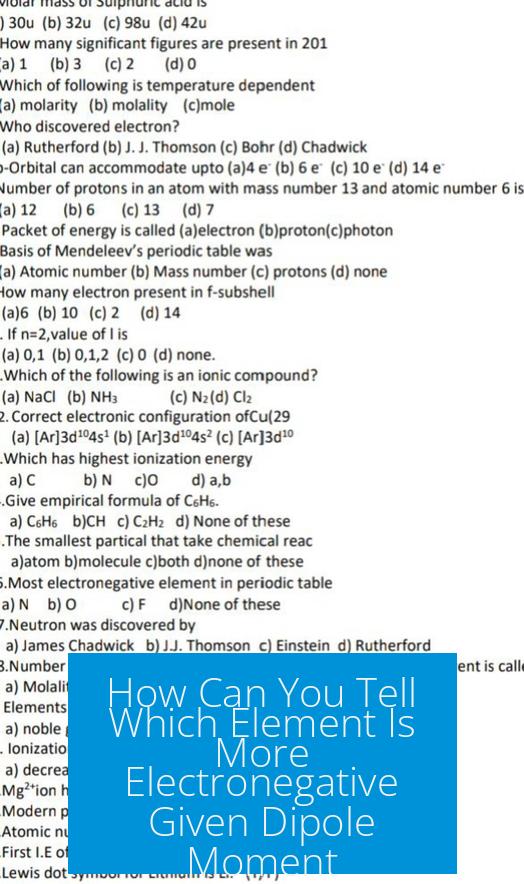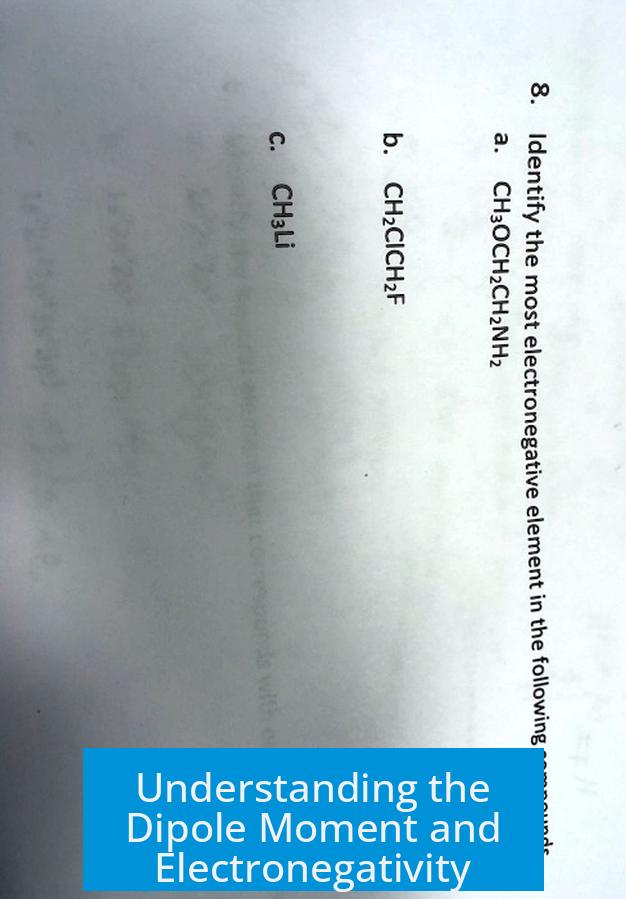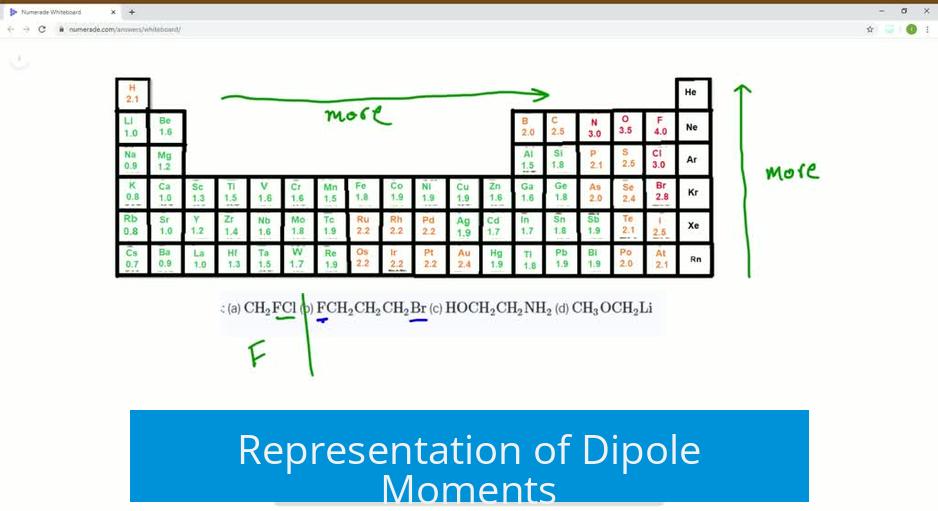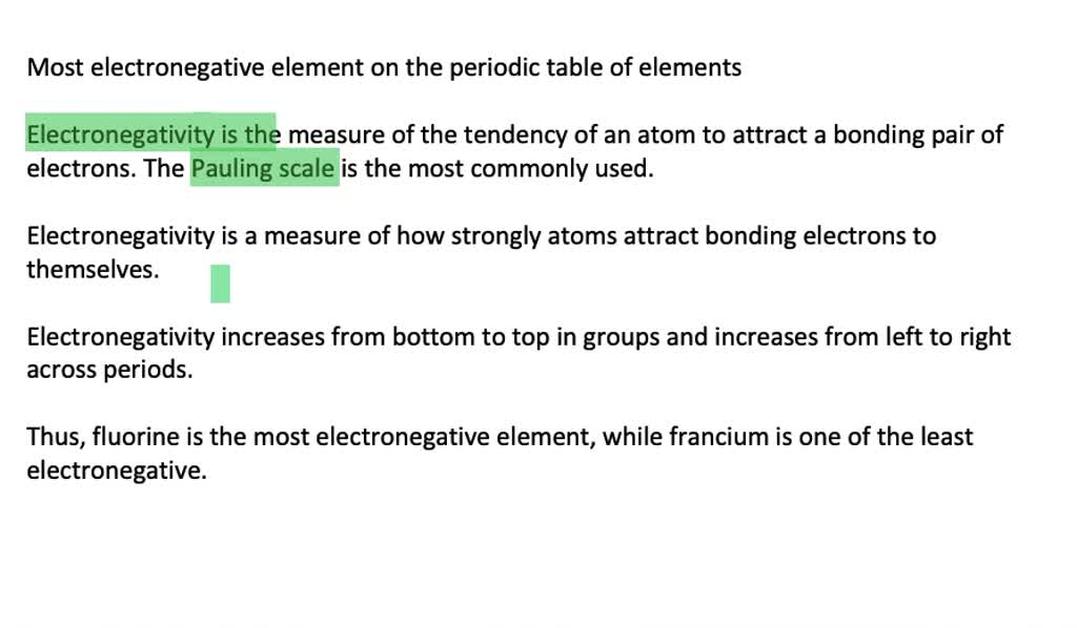How Can You Tell Which Element Is More Electronegative Given Dipole Moment?

The element toward which the dipole moment arrow points is the more electronegative element. This arrow illustrates the direction of electron density shift in a bond, from the less electronegative atom to the more electronegative one.
Understanding the Dipole Moment and Electronegativity

The dipole moment arises from an unequal sharing of electrons between two bonded atoms. This uneven sharing happens because one atom attracts electrons more strongly than the other. That atom is the more electronegative element.
In a chemical bond, electrons are shared but not always evenly. The atom with higher electronegativity pulls shared electrons closer. This causes a separation of electric charge, producing a dipole moment. The region close to the more electronegative atom acquires a partial negative charge, denoted δ−. The other atom becomes partially positive (δ+).
Representation of Dipole Moments

Dipole moments are shown with arrows along the bond axis. The arrow points toward the more electronegative atom. The base of the arrow is marked with a δ+ sign, indicating the partially positive end of the bond.
- Arrow tip: more electronegative atom (electron-rich, δ−)
- Arrow tail with plus sign: less electronegative atom (electron-poor, δ+)
This convention visually depicts the direction in which electrons are pulled.
Electronegativity Difference and Dipole Magnitude

The size of the dipole moment is related to the difference in electronegativity between the two atoms. Typically:
- ΔEN > 0.4 indicates a polar covalent bond with a noticeable dipole moment.
- Greater electronegativity difference means stronger electron pull and thus a larger dipole moment.
For example, the dipole moment in a bond between carbon and fluorine is larger than between carbon and hydrogen because fluorine is significantly more electronegative than hydrogen.
Using the Dipole Moment Arrow to Identify More Electronegative Elements
To determine which atom is more electronegative:
- Locate the dipole moment arrow on the bond or molecule diagram.
- Note the arrow’s direction—since it points from δ+ to δ−, it always points to the more electronegative atom.
- The atom receiving the arrow tip is the one pulling electron density more.
This simple method works for bonds between two different atoms. The dipole arrow serves as a direct guide to electronegativity differences.
Factors Affecting Dipole Moments in Molecules
Dipole moments and electronegativity relationships are influenced by:
- Molecular geometry: The 3D shape determines how bond dipoles add or cancel.
- Surrounding atoms: Nearby atoms with different electronegativities can either pull electron density away or push it toward the central atom, modifying the net dipole moment.
- Isotopic substitution: Isotopes like hydrogen and deuterium slightly differ in electron-pulling ability, which can impact dipole moments subtly.
Visualizing Dipoles in Three Dimensions
Consider a tetrahedral molecule with a central atom bonded to various atoms of different electronegativities. Dipole vectors for each bond act like vectors in 3D space.
The net dipole moment vector is the sum of these individual bond dipoles. When more electronegative atoms pull electrons in one direction and less electronegative ones push electrons in opposing directions, the net dipole moment magnitude adjusts accordingly.
For example, in a molecule like fluoromethane (CH3F), fluorine is the most electronegative and pulls electron density strongly. However, the hydrogens pull electron density in the opposite direction but less strongly, reducing the net dipole moment.
Electronegativity Trends Aid Interpretation
Electronegativity increases from left to right across a period and from bottom to top in a group on the periodic table.
Knowing this, if you encounter a dipole moment arrow on a bond involving elements from different positions in the periodic table, you can predict the direction and identify the more electronegative element accordingly.
Dipole Moment and Charge Separation: Conceptual Model
Imagine the bond as a tug of war over electrons. The more electronegative atom pulls harder. For example, fluorine “wins” against carbon or hydrogen because of its high electronegativity.
The electrons—the rope—shift toward the stronger puller, creating a partial negative pole at fluorine.
Summary of Key Points
- The dipole moment arrow always points to the more electronegative atom in a bond.
- Dipole moment size increases with greater electronegativity difference.
- Electronegativity follows a periodic trend: increases left to right and bottom to top.
- Molecular shape affects how individual bond dipoles combine into total dipole moment.
- Surrounding atoms’ electronegativity can influence the net dipole moment magnitude.
- Dipole moments visualize charge separation created by uneven electron density.
How Can You Tell Which Element is More Electronegative Given Dipole Moment?
Simply put: the element pulling the electrons harder—the one the dipole arrow points to—is the more electronegative element. This is your key to unlocking the electronegativity mystery using dipole moments.
Yet, like any good detective story, it’s not just about the arrow direction; it is about understanding the forces at play, the shapes the molecules take, and how surrounding atoms pitch in. Let’s dive into this electronegativity tug-of-war and see how dipole moments reveal who’s winning.
The Molecular Tug of War: Visualizing Electron Pull
Imagine a classic tug of war between Fluorine and Carbon, where the shared electrons in their bond are the rope. Fluorine, electronegativity’s MVP, pulls with all its might. The dipole moment measures “how far” the electrons shift from an equal, shared tug—like how far the rope moves toward one side.
When the dipole arrow points towards Fluorine in a molecule such as hydrogen fluoride (HF), that arrow indicates Fluorine dominates the electron refusal game. The electrons hang out more near Fluorine, giving it a partial negative charge, while the other atom takes a slight positive charge.
Dipole Direction: The Electronegativity Compass
The dipole moment vector is your molecular compass. It points from the less electronegative atom toward the more electronegative one. In chemical diagrams, you’ll often see an arrow on a bond showing this direction. A little plus sign typically notes the partial positive end, signaling electron deficiency.
This arrow’s direction is critical. The more electronegative atom “wins” by pulling the electron density toward itself, creating the dipole. So, no guesswork here: check the arrow to see who’s got the stronger pull.
Dipole Magnitude: How Strong is the Pull?
A bigger dipole moment means a bigger difference in electronegativity between atoms. If the electrons are shifted significantly towards one atom, you get a large dipole moment. For example, bonds between Fluorine and other atoms typically show large dipole moments because of Fluorine’s high electronegativity.
Dipole moments aren’t just signs; they carry numbers expressing electron shift magnitude. The larger the number, the larger the electron tug disparity and—the simpler way to put it—the bigger the electronegativity difference.
3D Shape and the Role of Neighboring Atoms
Things get more interesting inside a 3D molecule. The dipole moment isn’t just about two connected atoms; it also depends on other atoms attached to the central atom. Picture methane derivatives like CH3F — Carbon bonded to three hydrogens and one Fluorine.
In 3D space, Carbon sits at the center of a tetrahedron. The Fluorine atom pulls electrons strongly upwards, but the three hydrogens surrounding Carbon push electron density back, acting like a defensive squad in this tug of war.
If the hydrogens are replaced with deuterium (D), a heavier isotope of hydrogen, the dipole moment changes because hydrogen pulls slightly stronger on electrons than deuterium does. This subtle difference reduces the dipole moment when hydrogens stick around compared to deuteriums.
Push-and-Pull: Why Surrounding Atoms Matter
Dipole moments are a sum game. Each bond in the molecule contributes a vector—some pull electrons, some push them away. When these vectors align, the total dipole moment grows. If they cancel in different directions, the net dipole moment shrinks.
For instance, if atoms opposite Fluorine are somewhat electronegative, they pull electrons back toward themselves, decreasing the molecule’s dipole moment. If less electronegative or electropositive, they soften the pull on electrons by donating electron density toward Fluorine, increasing the dipole moment.
Polar Molecules: A Balancing Act
Think of polar molecules as a team of electron pullers and pushers. When atoms pull in all sorts of directions equally, the molecule might behave nonpolar overall because the pulls cancel out. But if strong pullers group on one side opposing electron pushers on the other, we get a clear polarity.
This spatial charge separation creates the dipole moment, and the atom responsible for the strongest electron pull is clearly more electronegative. The direction and magnitude of the dipole moment spotlight this difference beautifully.
Practical Steps to Identify the More Electronegative Element Using Dipole Moments
- Locate the Dipole Vector: Find the arrow attached to the bond in molecular diagrams. It points from the less electronegative element (partial positive) to the more electronegative element (partial negative).
- Check Partial Charges: The atom with a partial negative charge (δ–) is the more electronegative one because it holds electron density more tightly.
- Analyze Dipole Magnitude: A larger dipole moment value means a larger electronegativity difference between bonded atoms.
- Consider Molecular Geometry: Know that molecule shape affects how dipole vectors add or cancel out. This affects the net dipole and can give clues about relative atomic electronegativities.
- Account for Surrounding Atoms: Nearby atoms’ electronegativity influences overall electron distribution and dipole moment measurements. Substituting atoms can subtly adjust values.
Example: Understanding CH3F Versus CD3F
Consider the molecule CH3F—carbon bonded to three hydrogens and one fluorine. Fluorine yanks electron density towards it strongly, creating a dipole moment. However, hydrogens, being slightly electronegative, also pull on electrons, reducing the net pull by fluorine somewhat.
Replace hydrogen with deuterium to get CD3F. Deuterium pulls electrons less than hydrogen, so the dipole moment of CD3F is slightly larger. This difference in dipole moments confirms hydrogen’s comparative electronegativity over deuterium.
Electronegativity Trends Contextualize Dipole Moments
Remember that electronegativity increases across a period (left to right in the periodic table) and up a group. Fluorine tops the charts, making it an intense electron puller, while hydrogen ranks lower.
This trend explains why, in dipole measurements, fluorine always attracts the dipole arrow’s tip, marking its electronegativity dominance.
Summary: Reading the Dipole Moment Reveals the Electronegativity Winner
By analyzing dipole vectors in molecular structure, you can spot the more electronegative element. The dipole arrow reliably points toward the atom pulling electrons most strongly, showing charge separation within the bond.
Surrounding atom electronegativities, molecule shape, and subtle isotope effects all influence dipole moment size and direction. Understanding these factors allows precise identification of which element dominates the electron tug of war, illuminating electronegativity with clarity and detail.
Next time you see a dipole moment vector in a molecule, think about the tiny battle happening at a microscopic level. The direction and strength of that vector tell the story of which atom is more electronegative, backed by molecular geometry and electron distribution.
How do you identify the more electronegative element using a dipole moment arrow?
The dipole moment arrow points toward the more electronegative atom. This arrow shows the direction of electron density shift in the bond, from the less electronegative atom (partial positive) to the more electronegative atom (partial negative).
What does the presence of a dipole moment reveal about the atoms involved?
A dipole moment indicates a difference in electronegativity between two bonded atoms. The atom pulling electrons closer becomes partially negative, while the other becomes partially positive, producing charge separation.
Can electronegativity differences be quantified using dipole moments?
Yes. A difference in electronegativity greater than 0.4 usually creates a polar bond with a dipole moment. The larger the difference, the stronger the dipole moment and the farther the electron density shifts toward the more electronegative atom.
How does molecular shape affect interpreting which atom is more electronegative from dipole moments?
The 3D shape affects how dipole moments add up. Atoms with similar electronegativities can pull electron density back, reducing the overall dipole moment. Analyzing dipoles in three dimensions helps determine the true electron-pulling atom.
Why might hydrogen reduce the dipole moment more than deuterium in similar molecules?
Hydrogen is slightly more electronegative than deuterium. This means hydrogen pulls electron density better, lowering the net dipole moment more when substituting deuterium in a molecule.





Leave a Comment